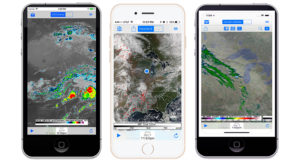
Use of ultrahigh radio frequencies by 5G wireless carriers could interfere with weather predictions. (Image source: SSEC)
Cell phones do not directly interfere with weather forecasts. However, there is concern with how cell phone signals travel through the atmosphere, particularly the 5G network.
The 5G technology is designed to carry more data and make wireless connections faster.
In March, the Federal Communications Commission began auctioning off ultrahigh radio frequencies for use by 5G wireless carriers.
These frequencies are appealing to telecommunication companies because they need to add capacity in urban areas to keep up with increased demand. But these 5G networks have unintended consequences.
Objections are being raised the National Oceanic and Atmospheric Administration and National Aeronautics and Space Administration and other federal agencies. Use of these frequencies for 5G could interfere with weather predictions.
The airwaves being auctioned are near frequencies used by NOAA satellite instruments to observe water vapor, rain and snow. For example, atmospheric water vapor emits a small amount of energy at these ultrahigh radio frequencies. Weather forecasters measure these signals from satellites and use the observations to understand how weather systems are likely to develop.
If networks transmit frequencies where water vapor emits energy, the satellite measurements will not be able to distinguish between those signals generated by the weather systems and the telecommunication signals. Loss of this weather information will impact the accuracy of weather forecasts.
Dr. Neil Jacobs, the acting NOAA administrator who oversees the National Weather Service, told Congress that loss of these weather data could reduce today’s forecast skill to what it was back in 1980.
This could become a global problem if other countries follow the US in using these frequencies for telecommunication. This fall, the World Radiocommunication Conference meets to set global agreements on use of radio frequencies for 5G.

